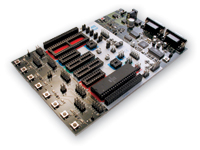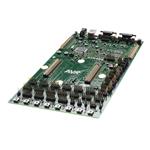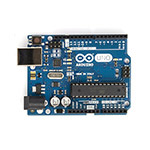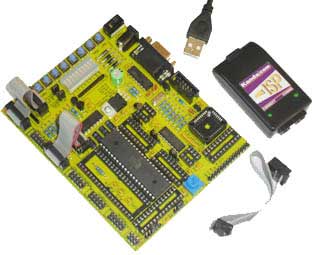Kanda have been making the STK200 starter kit for 15 years and it is still proving to be very popular. It was originally designed for Atmel and was the first low cost microcontroller training kit on the market and helped launch the AVR as a popular microcontroller.
Atmel have since moved on to STK500 and STK600 as the AVR portfolio has expanded but the original kit has many advantages, especially for beginners. Arduino has also entered the market but this serves a different purpose and won’t actually teach you much about microcontrollers.
If you are a novice with AVR microcontrollers, you have a few basic choices if we exclude lots of Chinese clones – STK200 from Kanda, STK500 or STK600 from Atmel and Arduino. All have their uses but the basic difference is summarised here:
- STK200 Designed for basic training on AVR microcontroller programming
- STK500 Development board for all AVRs, including Xmega and AVR32, now discontinued
- STK600 Latest development board for all AVRs, with plugins for all devices
- AVR XPLAIN Small evaluation board for ATmega128
- Arduino Getting a simple project running as quickly as possible
Atmel STK500 and STK600 AVR Boards
Atmel STK500 is now officially discontinued although it is still available from Atmel distributors and other sources. It is difficult to setup as it has many options with a complicated lead set and often requires extra modules to support different AVR microcontrollers. It includes various guides but doesn’t have any training material with it.

Atmel STK600 has now replaced the STK500, at least Atmel would like to think so. It is far more expensive than the other options and needs a module for every AVR package before you can use it. It is incredibly comprehensive and you can get socket and routing cards for every AVR, including Xmega and AVR32, in every conceivable package type. These include DIP, SOIC QFN and TQFP packages.

Both STK500 and STK600 are very good for advanced development. They are not particularly suited to beginners because of their complexity. It is hard just working out what boards and cards you need with the STK600 and STK500 has a complicated set of jumpers and leads that must be configured before you can start. Neither has any training material either.
AVR XPLAIN
The kit contains hardware for evaluating the analog functionality of Atmel AVR devices and demonstrating how to interface external memories. The kit includes 8MB SDRAM and 8MB DataFlash connected to the Atmel ATxmega128A1, and eight push buttons and eight LEDs for user interaction. The USB interface is a communication gateway between the ATxmega128A1 USB COM port and power source. The ADC can be used to read a temperature sensor and potentiometer, and the DAC can be used to generate sound on a mono speaker.
Arduino
Arduino kits are designed for rapid prototyping and there are lots of different project examples free on the web. They are good if you have a specific project in mind that you just want to get going and a similar project is available. But they are difficult to modify if your project has unusual features. Don’t believe that you will learn anything real about the AVR though, Arduino even hides the fact that it uses an AVR microcontroller.
What you are really doing is viewing microcontrollers through an Arduino prism, with a simplied language called Wiring and fixed hardware called shields. This makes it easy to copy a project to get something up and running quickly but doesn’t really increase your understanding of the AVR or the development environments and software languages used in industry.
The Arduino kit does not have a debugger option, which makes it harder to modify a project or sketch as they call it. Most Arduino programming is done by a bootloader. This is a piece of pre-written code that lives in the AVR chip and carries out the programming. The disadvantage is that you can only use devices with this code preloaded or have access to an AVR programmer that can load it.

STK200
The Kanda STK200 is designed for ease of use, with novices in mind. Although it does support many different AVR devices in DIP packages (and STK300 supports TQFP parts) this is for future work. Most training is done on a standard 40-pin ATmega16 chip. It has been updated over the years to support new AVR microcontrollers, USB and new Windows versions as well as AVRStudio 4 and AVRStudio 6, the Atmel development environments.
It assumes very little previous knowledge and starts with the basics of microprocessor systems, logic and numbering systems before covering assembly language and C programming. The kit includes a programmer or a combined AVR Dragon programmer and debugger with the more advanced STK200-DRAGON kit. It also includes guides, datasheets, schematics and lots of sample projects.

Conclusions
If you want an advanced AVR development kit, with support for different package types, then the Atmel STK500 or STK600 kits are probably the best choice. For quick results, without having to learn very much or to copy a specific existing project, then Arduino can’t be beaten. If you actually want to learn about AVR microcontrollers and how to program them, then choose the STK200 or STK200-DRAGON.
